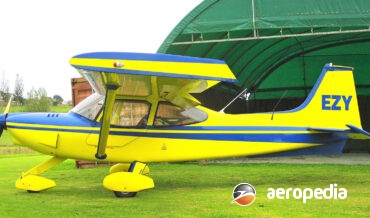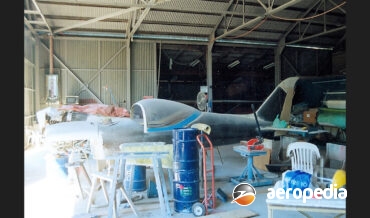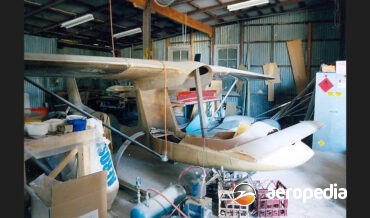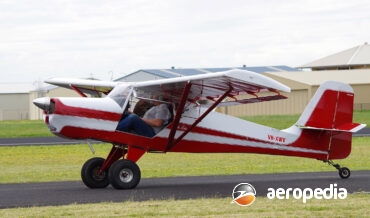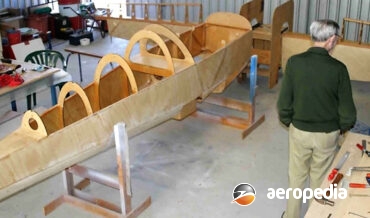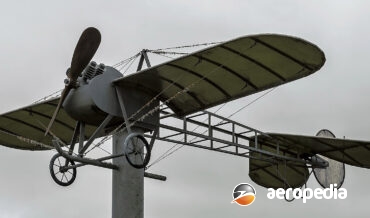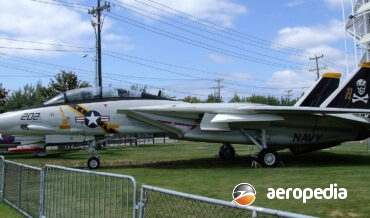All Contents
Contents
This was an ultra-light aircraft designed, built and flown by Christopher Conroy, who later designed the Sparrow and Sparrowhawk range of light aircraft.
David C. Eyre
- May 25, 2020
The Cli-Mate commenced life as a Foxcon Terrier 200 but received some major changes during its construction. It initially became ZK-EZY² (c/n NZ2006) and was registered on 21 July 2004 to the Paul Hopper and Rex Swenson Partnership.
David C. Eyre
- May 25, 2020
Very little is known about this aircraft. It was placed on the RAA register on 27 January 2005 as 19-4255 (c/n CAA-001) and removed on 27 January 2006.
David C. Eyre
- May 25, 2020
This was an ultralight aircraft designed and built by Mr Alan Clarke. It was powered by a Fuji Robin 250 engine and had an empty weight of 84 kg (186 lb).
David C. Eyre
- May 25, 2020
Designed and built by Mr Raymond Tolhurst of Composite Aero Components of Camden, NSW, the White Pointer was one of a series of high-performance light sporting aircraft designed by this company aimed at the sport aviation fraternity.
David C. Eyre
- May 25, 2020
The Kingfisher is a one off two-seat low-wing cabin monoplane designed and built by Mr Clark. This aircraft is powered by a 90-kw (120-hp) Jabiru 3300 six-cylinder engine and was first registered as 19-7104 on 24 March 2009.
David C. Eyre
- May 25, 2020
This aircraft was designed by Mr Raymond Tolhurst as an all-composite light sporting aircraft for his Company Composite Aero Components of Camden NSW.
David C. Eyre
- May 25, 2020
The Cielo Lobo is a light sporting aircraft built by amateur builders. Work commenced on the construction of the first Australian aircraft in 2002 and it was eventually completed and registered with the RAA on 21 July 2010 as 19-7577.
David C. Eyre
- May 25, 2020
The Colby is a single-seat ultralight aircraft built by Mr Colin Thorpe and is basically a Flightstar modified by the builders to meet their needs.
David C. Eyre
- May 25, 2020
In Queensland early in about 2000 an amateur constructor designed and built a scale replica of a twin-engine, push/pull, Cessna 337.
David C. Eyre
- May 25, 2020
The Imp is a light aircraft of all wood construction with fabric covering designed and built by Murray Cohoe at Serpentine in Western Australia. It was nearing completion late in 2007.
David C. Eyre
- May 25, 2020
This aircraft was a glider imported from the United States where it had operated as N642BA (c/n 101A-0187) It was first registered in Australia as VH-BII on 5 March 2008.
David C. Eyre
- May 25, 2020
As noted elsewhere, Steven Cohen came from a background of hang gliding and was a successful manufacturer of hang gliders.
David C. Eyre
- May 25, 2020
This aircraft was a homebuilt Vans RV-4 quick-build kit constructed by Carl Wright of Ventura, California and was registered in the United States as N67CW.
David C. Eyre
- May 25, 2020
Steven Cohen, along with Colin Winton, is recognised as one of the most prolific designers of Ultralight Aircraft in Australia.
David C. Eyre
- May 25, 2020
In about 1935 Keith Cameron built a small single-seat monoplane. It was of wood construction with fabric covering. It was not thought to be intended to fly and was only used for taxiing training duties.
David C. Eyre
- May 25, 2020
This aircraft was designed by prolific aircraft designer in Australia, Steven Cohen, in 1983. It is an extremely simple aircraft and, other than for the tail it was all straight tube and plate.
David C. Eyre
- May 25, 2020
This is an amphibian designed and built by prolific designer and builder, Steven Cohen, at Wedderburn, NSW, with work commencing in 2018 and continuing into 2019.
David C. Eyre
- May 25, 2020
This was a two-seat single-engine light aircraft designed by a Mr Finch at Warwick in Queensland for private use of metal and composite construction.
David C. Eyre
- May 25, 2020
Nothing is known about this aircraft at this stage but it was registered as VH-XFB (c/n Freckle 1) to its owner Adam Barrow of Murrumbeena, Vic on 16 March 2017.
David C. Eyre
- May 25, 2020
This was a light biplane homebuilt built in Melbourne with a pusher engine built by Keith Farmer, owner of Sopwith Gnu VH-UBY.
David C. Eyre
- May 25, 2020
The Fox Brothers of St Kilda, Vic over a period of 18 months built a small biplane. This machine was flown by N Chapman on 7 May 1932 from the Dudley Street Airport (later Coode Island) and attained a height of 305 m (1,000 ft) and completed two circuits of
David C. Eyre
- May 25, 2020
The Corella 1 was a single-seat, high-wing monoplane with a single-engine and tailwheel undercarriage designed and built Glenda Faint.
David C. Eyre
- May 25, 2020
The Rogal Biplane is an Australian designed ultra-light aircraft with open cockpit built to suit the purposes of the designer.
David C. Eyre
- May 25, 2020
Messrs F A Evans and J M Chalmers in the early 1930s obtained some parts from the wreck of the Vickers Vellore which force landed at Cape Don, NT after engine trouble in May 1929.
David C. Eyre
- May 25, 2020
The Mustang is a minimum aircraft and a single-seater. Examples have been constructed in this region, one becoming ZK-FIV (c/n 1113) in New Zealand in May 1984.
David C. Eyre
- May 25, 2020
This was a design of an aircraft directed to winning a prize of £5,000 ($10,000) offered by British philanthropist Henry Kremer for a man-powered aircraft to fly a mile (1.6 km) and achieve an altitude of 3.048 m (10 ft).
David C. Eyre
- May 25, 2020
This was a one-off ultra-light aircraft designed and built by Rodney Flockhart. It was allotted the registration 10-3468 (c/n 1) and appeared on the RAA register from 18 December 2000 to 7 September 2005.
David C. Eyre
- May 25, 2020
This aircraft was placed on the Australian civil aircraft register on 26 July 2017 as VH-BNF6 (c/n AES-B1) and is owned by ESE Ltd of Upper Throic Farm, Marsbury Wells in Somerset in the United Kingdom and the aircraft is operated by ESE Australia Pty Ltd of Yarralumla, ACT.
David C. Eyre
- May 25, 2020
This aircraft was an Australian designed and built amphibian which was registered with the RAA as 19-7206 (c/n A001) on 13 July 2009.
David C. Eyre
- May 25, 2020
This is a light aircraft built in New Zealand in the Keri Keri area by Allan Fillery and was a conversion of a Zenair CH-701 kit with some owner/builder modifications.
David C. Eyre
- May 25, 2020
The Javelin was an ultralight built by Flightstar Australia Limited and a number of examples have been registered with the RAA, including 10-1303 fitted with a Rotax 447 engine registered on 5 September 1991.
David C. Eyre
- May 25, 2020
This was an ultralight aircraft produced in Australia in the early 1980s and was powered by a 429-cc 28-kw (37-hp) Cuyuna engine.
David C. Eyre
- May 25, 2020
David Percival Fisher was an engineer involved in early aviation experimentation in the Wellington region of New Zealand in the early 1900s, building his own design monoplane, with the help of Reginald Harry White, in 1912.
David C. Eyre
- May 25, 2020
This was an all-composite light aircraft designed by Scott Taylor and Robert Herring of Custom Aircraft at Mildura.
David C. Eyre
- May 25, 2020
This machine is basically a two-seat development of the Sadler Vampire. The aircraft was initially developed by the designers of the Vampire but was never completed when the original Australian production line closed down.
David C. Eyre
- May 25, 2020
This was a light touring biplane which was registered with the RAA as 19-4105 and appeared on the register from 28 April 2004 to 28 April 2005.
David C. Eyre
- May 25, 2020
This was a single-seat, full scale replica of a Supermarine Spitfire by Mr Gerald Finch at Mareeba in Queensland. Of all metal construction, it was painted in a camouflage colour scheme and registered VH-NEY (c/n 0010708).
David C. Eyre
- May 25, 2020
The F-14 Tomcat for many years was one of the most potent interceptor / fighters in the armoury of the US Navy and saw combat on a number of occasions operating from aircraft carriers of the US Fleet.
David C. Eyre
- May 25, 2020
This was a one-off homebuilt gyrocopter built around the cockpit section of a Robinson R-22. The machine is fitted with a tricycle undercarriage and was fitted with a Subaru EJ25 engine driving in a pusher configuration behind the cockpit, being fitted with a three-blade Ivo 1.93 m (76-inch) propeller.
David C. Eyre
- May 25, 2020
Recent Comments
Archives
Categories
- No categories
Categories
- No categories
Latest Posts
Newsletter


